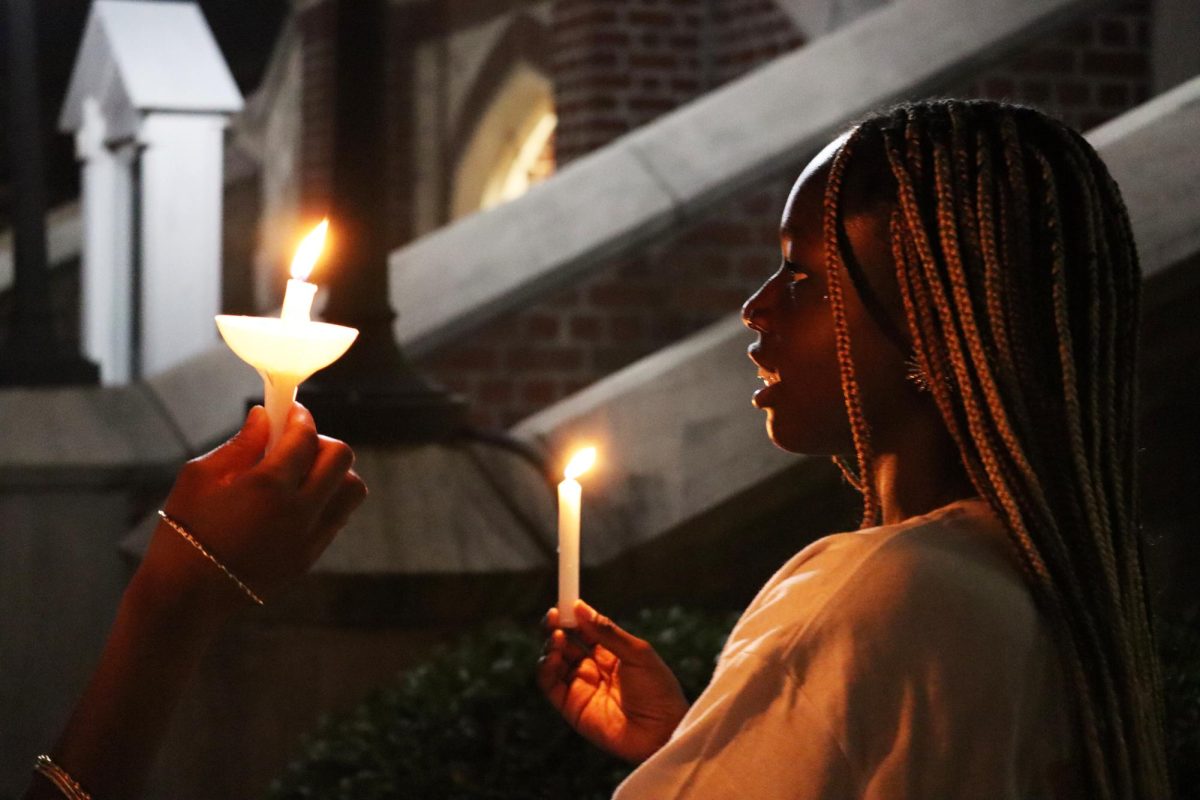For Elliot Sanchez, college students became fifth graders for five minutes.
Sanchez, Loyola A’08, gave a lesson on the Pythagorean theorem.
A2 + B2 = C2. If students know the lengths of two sides of a triangle, they can use this method to find the third length he explained.
Sanchez was not just giving a math lesson to these 5th graders; this was his final interview for Teach for America.
According to Laura Vinsant, recruitment director for the Gulf Coast region, Teach For America’s mission is to eliminate educational inequity that limits children living in low-income communities. She said across the United States, there are 15.5 million children living in poverty and only one in 10 of them will ever graduate from a university like Loyola.
The final interview requires applicants to give a sample lesson. It could be on any subject, any topic, to any grade level from kindergarten through 12th grade.
Applicants not only presented to their judges, but also to the other half dozen applicants.
Sanchez chose his lesson because of a feeling he got when he was a fifth grader.
When his fifth grade teacher taught his class the Pythagorean theorem, he had a “Eureka!” moment. He understood what the concept meant and how to apply it. He said it was a profound moment in the shaping of his education.
At the time, pretending brought comfort to him. “I had to pretend the other applicants were fifth graders instead of college students judging me,” Sanchez said.
Eventually, he found the real thing to be more stressful.
Teach For America enlists the country’s top college graduates to teach for two years in one of their 39 regions across the United States. Vinsant said that last year, two 2010 Loyola graduates entered into the program to begin teaching in the 2010-2011 academic year. In 2009, six graduates began teaching in the 2009-2010 academic year, making Teach for America the largest employer of Loyola graduates, and six also began teaching in 2008 for the 2008-2009 academic year. Their national acceptance rate is about 12 percent.
In 2008, Sanchez was one of those six. He received an e-mail saying he was chosen to be a teacher. Later, he received a box in the mail. Inside were 14 books, about 250 pages each, of pre-reading.
“I went from being excited to realizing the work has just begun,” Sanchez said.
His inspiration for teaching began during his freshman year at Loyola. The university’s First Year Common Reading Program had students read a book the summer before their freshman year. The common reading for his class was “Savage Inequalities: Children in America’s Schools” by Jonathan Kozol. It is about the inconsistencies throughout the country between school districts in more prosperous suburban areas and in urban areas. Students were able to listen to him give a presentation on his book.
The experience inspired Sanchez to tutor in the area. He was involved in programs like Young Aspirations Young Artists and Renaissance Reader, both as an undergraduate. He said people could tell the advantage students in private schools had over those in public school, even within a few blocks of Loyola.
Teach for America became an option after Sanchez found out about it through a friend.
“It seemed like a natural way to continue the work I started and make it a primary focus, considering the huge need from students in the community,” Sanchez said.
At first, Sanchez said he was submitting resumes and essays. After the initial application, some applicants receive an e-mail, inviting them to a phone interview. The final interview comes next, after receiving another invitation.
Sanchez spent five weeks training at Southwest Elementary School in Phoenix, Ariz. From about 7 a.m. to noon, he took teaching courses and from noon to 3:30 or 4 p.m., he taught a summer school class.
On his first day, Sanchez said he got up at 5 a.m., went over lesson plans and rehearsed lines in his head. It was exciting for him to get in front of the class. He stopped thinking about it, and began teaching.
“By the end of the first lesson, it was a blur, but I was incredibly excited to have spent my first day as a real teacher.”
The real challenges, however, started at the end of the first week. His students’ test scores were abysmal; they were at about the same level as they were at the beginning of week. He said he knew it was his fault they had not improved.
Sanchez said training in the morning was a full course load, especially while having a full-time job as a teacher. In addition, he and his colleagues spent each night lesson planning for the five subjects they taught. The 14 to 15 hour days made him feel constantly overwhelmed. He said he felt like he snuck into something he was not qualified for. But, he said, that feeling is a normal part of the process.
By the end of the five weeks, he said students showed that they mastered what they were learning, even though he was still learning, too.
“It was the first time I had students of my own. I got to know their personalities.” Sanchez said. He said that took education inequity from being abstract to personal. “Seeing them made me want to work harder.”
Sanchez continued the program, teaching for one year at Booker T. Washington Transitional School in New Orleans and at KIPP: Endeavor Academy in Kansas City, Mo. for the next. His experience led him to his current position—Turnaround Policy Analyst for the Louisiana Department of Education. He is also a Louisiana Education Reform Fellow.
Precious Esie can be reached at






